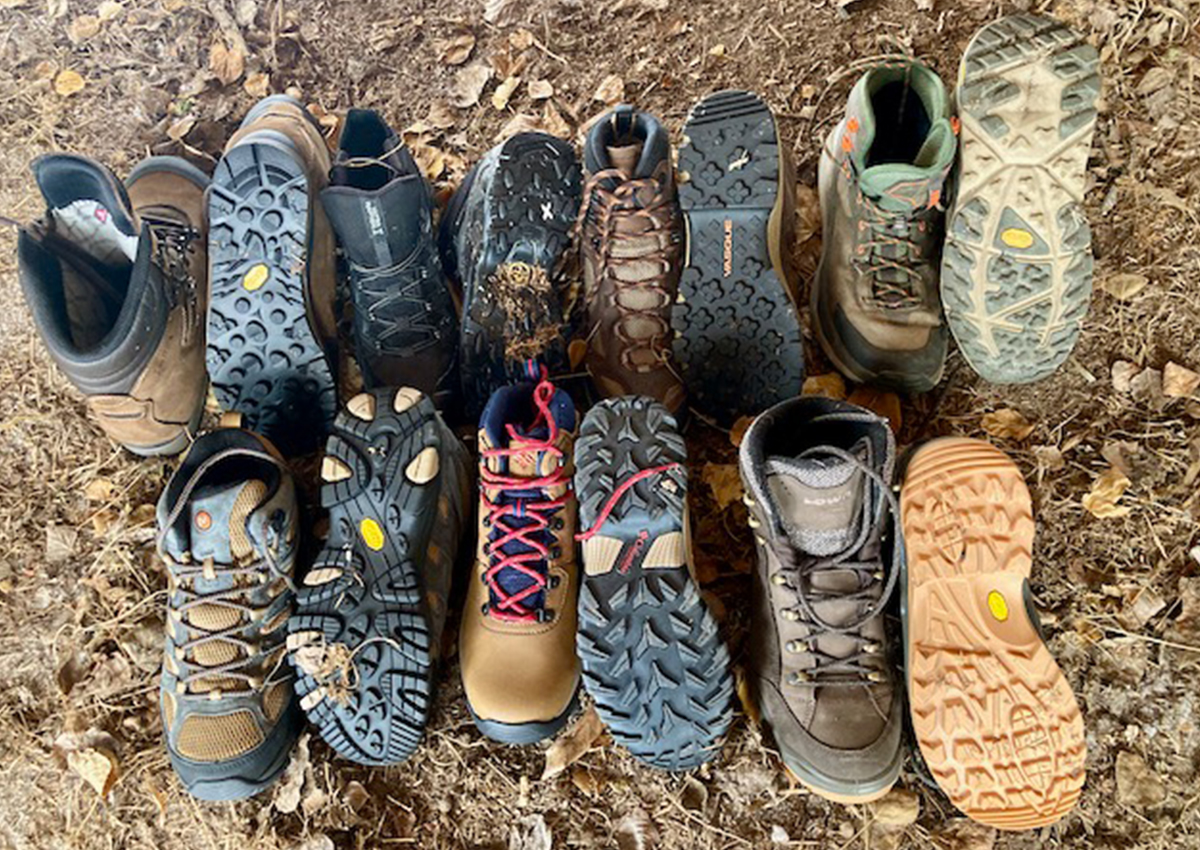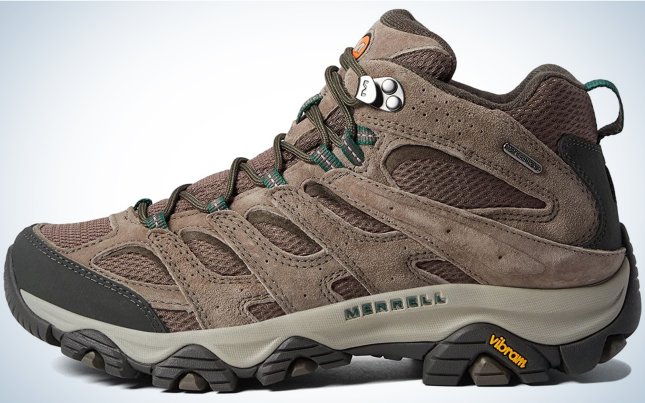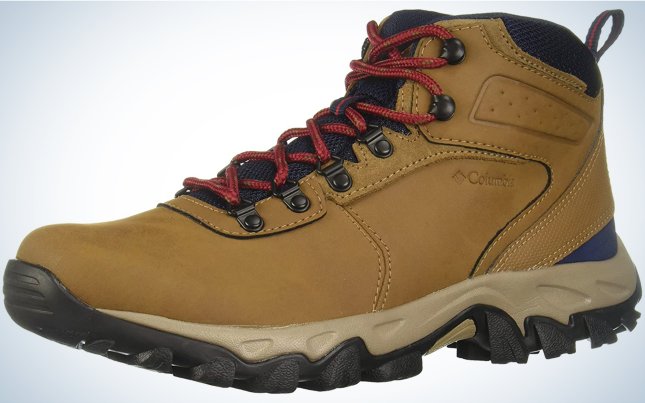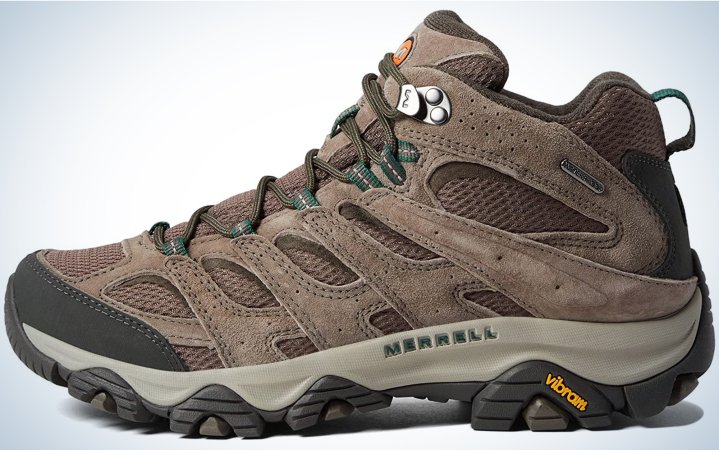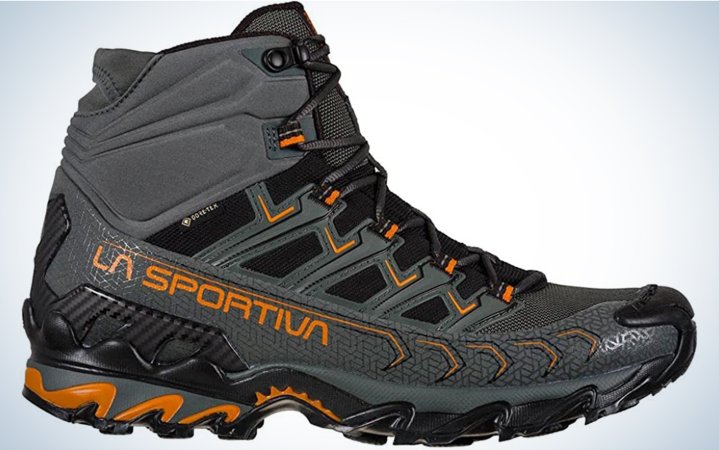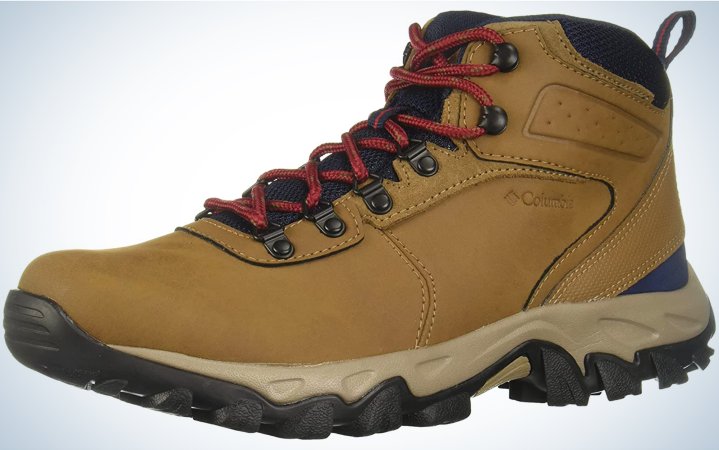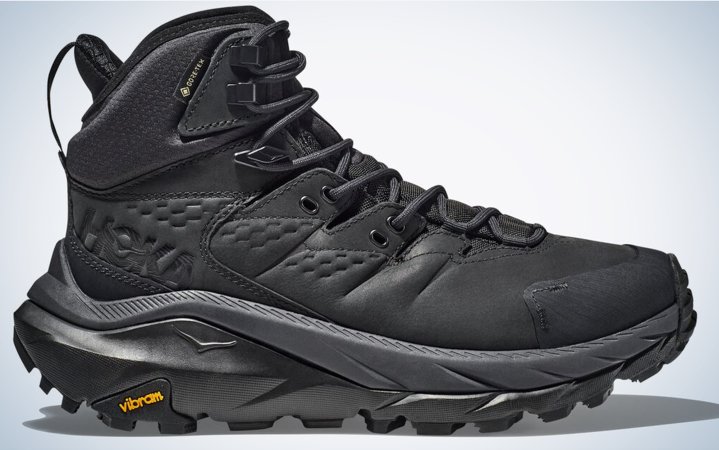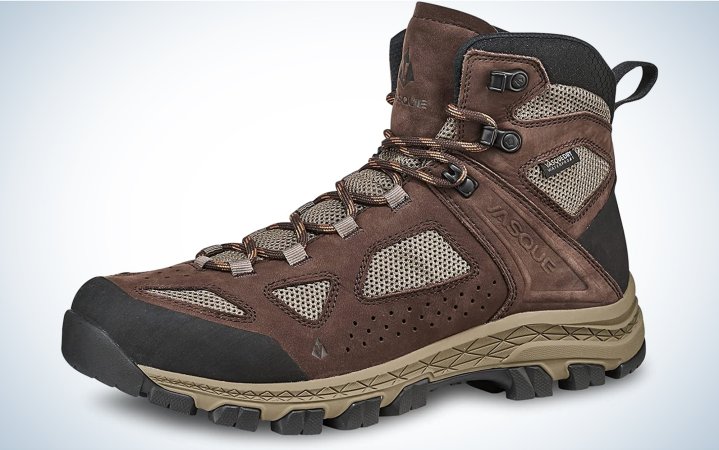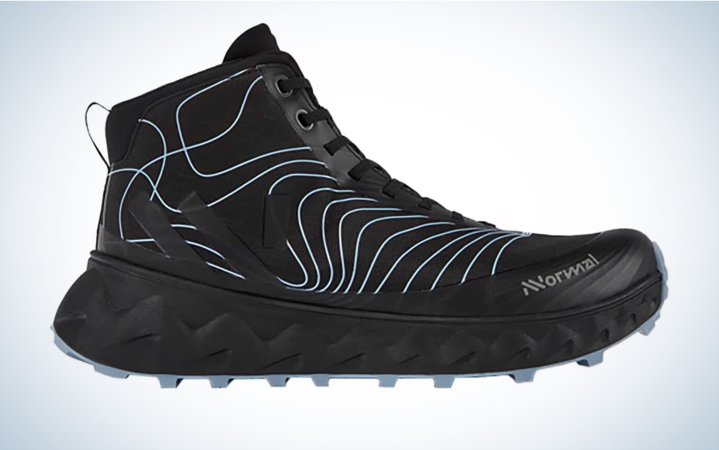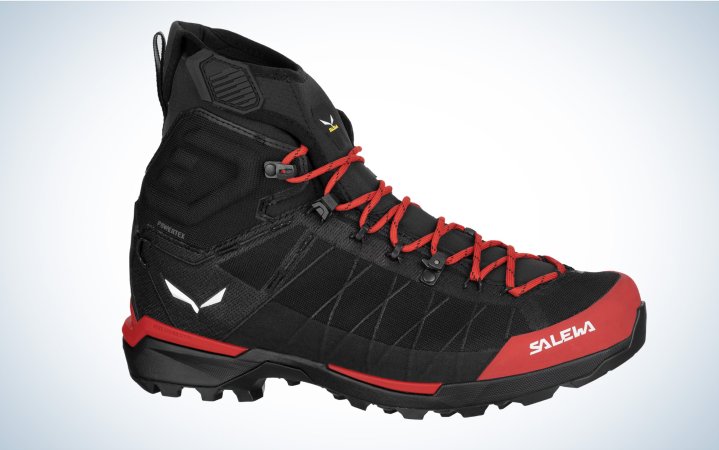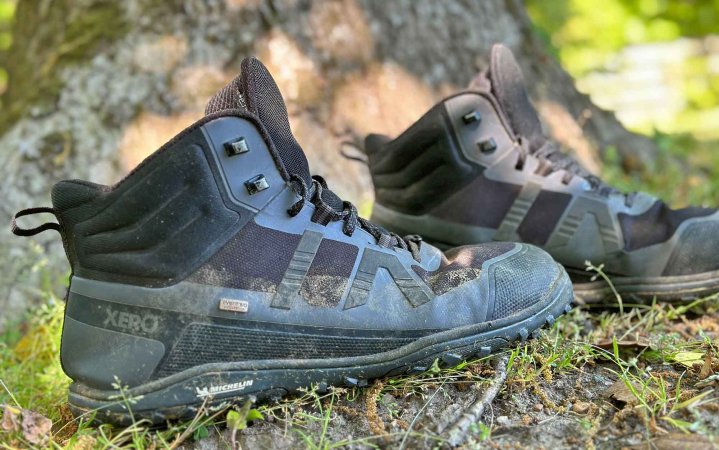We may earn revenue from the products available on this page and participate in affiliate programs. Learn More ›
Full disclosure: I used to be a naysayer of hiking boots. I felt they were too heavy and bulky, inevitably slowing me down. However, as I got more adventurous, my stringent viewpoint started to change. Before I set out on my thru hike of the Appalachian Trail in 2011, I narrowed in on the Merrell Moab low-cut hiking shoe as the best option for that trail. My wife wore the mid-cut height of the female version. We hiked all 2,181 miles of the Appalachian Trail in Merrells. When we set off to thru hike New Zealand’s Te Araroa, my wife convinced me a mid-cut hiking boot was better suited for that trail. Another 2,000 miles later, my feet appreciated the beefier boots.
Now that we live just outside of Denali National Park and Preserve and I work as a backcountry guide, I am a full-on convert and wear nothing but boots. The gnarly and unforgiving terrain would eat up my low-cut trail runners. Below I tested and reviewed multiple options to help you choose one of the best hiking boots for men that fits your needs.
- Best Overall: Merrell Moab 3
- Best for Mixed Terrain: La Sportiva Ultra Raptor II Mid GTX
- Best Budget: Columbia Newton Ridge Plus II Waterproof
- Best Lightweight: Hoka Kaha GTX 2
- Most Versatile: Vasque Breeze
- Best for Bushwhacking: Meindl Comfort Fit Hunter 400
- Best for Long-Distances: Nnormal Tomir Mid WP
- Best for Snow and Ice: Salewa Ortles Light Mid Powertex Boot
- Best Barefoot: Xero Scrambler Mid II WP
How We Tested the Best Hiking Boots for Men
I have been a hiking shoe and trail runner guy for some time. But over the last 10 years, I almost exclusively use hiking boots (mainly mid-boots) as the rough backcountry of Alaska is no place for dinky shoes. I chose boots that have worked for me over the years and models from the best hiking boot companies from around the world. I wore all of the boots on this list hiking and also drew from my extensive experience with the Hoka, Merrell, and Vasque models. Then, I verified manufacturer claims with real-world testing. Are they truly waterproof? Do they have the best traction? I also noted, most importantly, are they comfortable for my feet? There is no reason to continue wearing boots that cause blisters or pain when the list of quality hiking footwear is so extensive.
Best Hiking Boots for Men: Reviews & Recommendations
Best Overall: Merrell Moab 3
Key Features
- Available Sizes: 7-15
- Regular and wide options
- Weight: 2 pounds
- Price: $120
Pros
- Affordable
- Durable
- Vibram outsole
Cons
- Only mid-ankle cut
- Mesh sections can get pulled
I hike all over the world and I pay attention to what gear people are using, including hiking shoes. I see Merrells crushing trails all the time, and I personally have worn several types of Merrells for well over 3,000 miles. My go-to is the Moab series because of the comfort, stubby traction, and reliability.
The new Moab 3, launched in 2022, stepped up Merrell’s game since the initial Moab debut in 2007. New features and updates include an enhanced footbed, arch support, heel reinforcement, eco-friendly materials, and a better outsole. The TC-5 Vibram outsole is made of a grippy rubber for better traction on everything from dirt to snow to slick rock. This proved true for me during a wet and muddy hike just outside of Denali National Park and Preserve where the grip kept me from slipping on the mixed terrain. Merell’s Moab 3s come in non-waterproof, waterproof, and Gore-Tex waterproof.
Best for Mixed Terrain: La Sportiva Ultra Raptor II Mid GTX
Key Features
- Available Sizes: 6-15.5
- Regular and wide options
- Weight: 2 pounds
Pros
- Breathable
- Waterproof
- Thick rubber toe cap
Cons
- Pricey
This shoe bridges the gap between a trail runner and scrambling boot. It’s ready for unexpected weather, but without added weight and bulk. The outsole has one set of raised oval-shaped lugs that grip dirt and rock, as well as another set of lugs for stability by biting into the terrain for push off. The center of the insole has a deep cup with two big lugs on the back end that act as a braking system for hard stops or descending a steep slope.
The boot is wrapped in an abrasion-resistant breathable mesh that is tough against rocks and sticks and does not allow in small debris. The toe of the boot is reinforced by a huge rubber cap that absorbs impact and tackles obstacles in the terrain. I do worry that because the rubber is not flush with the boot it could peel back over time, but it has yet to happen.
As for weather protection, the whole boot is wrapped in Gore-Tex to keep your feet dry at all times. A simple, but secure, lacing system with one eye hook keeps the boot snug. The heel does not have a pull loop, but rather a fold in the material that allows you to get a finger in to pull the boot on.
Best Budget: Columbia Newton Ridge Plus II Waterproof
Key Features
- Available Sizes: 7-17
- Regular and wide options
- Weight: 2 pounds
- Price: $100 but frequently on sale
Pros
- Affordable
- Waterproof
- Wide range of sizes
Cons
- Not a lot of ventilation
Boots don’t have to be hundreds of dollars to make the cut. I caught the Newton Ridge Plus II Waterproof on sale at $60, a steal. The lower portion is made of leather and suede, which is great for rough and rocky terrain. The upper collar and tongue is mesh, which offers breathability — albeit not a lot. These leather hiking boots are a great three season boot, but not for temps below freezing.
Columbia’s Newton Ridge Plus is completely waterproof with a proprietary outsole that has a mix of multi-directional lugs perfect for gripping on loose dirt and gravel, snow, and especially for steep climbs and declines. Even though it is a mid-boot, it has ample lower ankle support thanks to the lacing system that threads through four metal triangle eyelets as well as two open top hooks along the ankle. These are a great option for beginners looking to try hiking without investing in an expensive boot or skilled hikers on a budget.
Best Lightweight: Hoka Kaha GTX 2
Key Features
- Available Sizes: 7-15
- Weight: 2 pounds
- Price: $240
Pros
- Lightweight
- High ankle support
- Cushy footbed
Cons
- Expensive
- No wide options
These are the lightest hiking boots with a full high top (7 inches) out of all the high top boots tested. I wore the Kaha GTX for two summers of guiding in the Alaskan bush, logging about 300 miles. They have been my go-to for everything from exposed alpine tundra hikes to rocky slopes. The design of the sole has a very slight arch, which creates a rocking motion to spring my steps forward. I feel a bounce in my steps along with the enhanced cushion. Released just last year, the GTX 2 has a more plush cushion and my feet never ached or fatigued. The newest GTX also utilizes more sustainable materials, like recycled Gore-Tex textiles. These are one of the few pairs of boots that I don’t feel I need to replace the insole with aftermarket versions because of the ideal shock absorption.
I tramped through wet and muddy swamps and the Gore-Tex lining kept my feet completely dry. Comprised of Vibram Megagrip, the multi-directional rubber lugs of the outsole gripped well and kept me moving forward. If there are any downsides, it’s been my experience that after extensive use—especially after hiking on sharp lava rock—the outsoles do wear down faster than other boots I’ve tested.
Some say that the Hokas look like moon boots. Likely the extreme cushioning and oversized toe box give this impression. However, once you put on the comfortable hiking boots, complete with optimal toe splay, you might not mind a few funny looks.
Read Next: The Best Lightweight Hiking Boots
Most Versatile: Vasque Breeze
Key Features
- Available Sizes: 7-14
- Regular and wide options
- Weight: 2.5 pounds
- Price: $160
Pros
- Breathable
- Waterproof
- 7-inch ankle support
- Extensive lacing system
Cons
- One direction outsole
The Breeze is a staple of the Vasque brand and a favorite among hikers and backpackers for 20 years because of its performance and affordable price. While keeping the comfort and durability of the classic boot, the new edition modernized the waterproofing with its own technique called VasqueDry, which uses 25 percent recycled materials.
The Trail Strider outsole is also proprietary to Vasque and provides traction with its thick and aggressive clover-shaped lugs dispersed all over the bottom of the boot. This versatile boot can perform in multiple terrains with a 7-inch top to keep out various debris. The upper of the boot is made of a Nubuck waterproof leather mixed with a polyester breathable mesh. All around a good boot that can last hundreds if not thousands of miles.
Read Next: Vasque Breeze LT NTX: Don’t Sacrifice Support for a Lighter Hiking Shoe
Best for Bushwhacking: Meindl Comfort Fit Hunter 400
Key Features
- Available Sizes: 6-15.5
- Regular and extra wide options
- Weight: 4.8 pounds
- Price: $350
Pros
- Waterproof
- Insulated
- High ankle support
Cons
- Heavy
- Expensive
Bombproof. Simply as that, these boots scream for you to take them out and try to break them down. I thought for sure I would cause some damage blazing through snow and ice, over rocky and muddy mountains and traversing icy river beds. However, they stood up to my durability testing and kept my feet warm and dry. Made with a full-grain nubuck leather and wrapped in Gore-Tex from the sole to the top of the ankle, they shield away water plus deflect thick brush, sticks, and rocks.
They are not meant for your everyday warm weather hike, as they contain 400 grams of Primaloft Gold that keeps your feet insulated against cold. I wore these for a full day in deep snow with temps dipping below -25 degrees with one thin pair of merino wool socks, and my feet stayed toasty.

The eye hooks spanning up the boot allow you to control tightness and one hook in the middle of the tongue cinches it to your calf comfortably. This boot is the most supportive one in the test with the cuff reaching 9.25 inches up your ankle with detailed lacing keeping it snug. The footbox felt very roomy while my heel never lifted, preventing unnecessary rubbing that can cause blisters.
Meindl has partnered with Vibram for an exclusive outsole that dominates anything I tested. It is called a Multigrip 6.0 that provides technical gripping with lugs that have a cut pattern in the middle. I feel these boots—with proper care—can last a lifetime and are best suited for long hunting, backpacking, and winter trips where warmth, support, and comfort are key to keep you moving forward.
Best for Long-Distances: Nnormal Tomir Mid WP
Key Features
- Available Sizes: 7.5-13.5
- Regular options
- Weight: 1 pound, 7 ounces
- Price: $185
Pros
- Lightweight
- Waterproof
- Vibram sticky outsole
Cons
- Costly
This new-to-the-market, Spanish brand launched in 2022 in collaboration with world-renowned mountain runner Killian Jornet. According to the brand, these are selling very well in the thru hiker and trail runner world. My first impression of the boot was that it remined me a lot of the Hoka brand, as they are super lightweight and breathable with a thick Vibram outsole that really grips on rocky trails.
One unique detail is that the laces are not centered. Instead, they lace up on an angle from the top towards your instep. I noticed it provided optimal ankle support as the upper really hugged your ankle. I wore these on and off trail traversing 200 miles while scrambling over rocks, thick brush, mud, and even snow. They feel super secure and comfortable with the thick cushion inside. Even the unforgiving Alaskan bush hasn’t torn or ripped them, so they have proven durability.
Best for Snow and Ice: Salewa Ortles Light Mid Powertex Boot
Key Features
- Available Sizes: 7-13
- Regular options
- Weight: 2 pounds, 9 ounces
- Price: $300
Pros
- Lightweight
- Waterproof
- Crampon compatible
- Internal gaiter
Cons
- Expensive
- Not meant for warmer temps
These bridge the gap between a mountaineering boot and winter hiking boot. The Ortles are great for ice, snow, rocks, and alpine adventures. The propriety rubber outsole has more than 25 large lugs that work well to keep you grounded in snow. I love that the pull loop on the back of the boot has a dedicated pocket to store it away so won’t catch it on anything, like a crampon. Proving their versatility even more, they come with two different footbeds for more or less cushion.

Justin La Vigne
The boots have a stiff lower section made of rubber and plastic to keep your foot in place while seven grommets keep your lacing tight around the foot. I love that the grommets are closed and keep the laces in place and only the outer top grommet is opened to pull the laces tightly. A rare feature is the included elastic gaiter that secures around your ankle with a simple velcro buckle and cinches tightly to keep snow and debris out.
Even in temps below freezing with one sock, my feet stayed plenty warm. Admittedly, when the temps dipped below 0 and into the negatives, they were not warm enough. As such, I would peg these for colder days hovering around freezing in mixed terrain.
Read Next: The Best Hiking Boots, Tested and Reviewed
Best Barefoot: Xero Scrambler Mid II WP
Key Features
- Men’s Sizes: 6.5 to 15
- Women’s Sizes: 5 to 12
- Weight Per Boot: 12.2 ounces (men’s size 9); 1 pound, 0.3 ounce (measured men’s 14)
- 5,000 mile sole warranty
- Waterproof
- Uses eVent a bio-based, planet positive, and waterproof membrane
- Michelin sole
Pros
- Good compromise between a traditional hiking boot and minimalist shoe
- True sizing
- Grippy sole
- Wide toe box
Cons
- Some people will need a transition period to get used to these boots
I started my journey into zero-drop shoes two years ago with a pair of Altra Lone Peaks, and they radically changed my opinions on hiking shoes. I then tried Xero HFS II shoes, which turned me from a barefoot convert to a zealot. They allow me to walk with a more natural gait, which relieved my nagging knee and hip flexor pain. Yet, some activities require more support and I’m more comfortable with a mid-height boot. I still don’t want the weight or heel height of a traditional hiker though.
That’s the niche the Scrambler Mid II WP fills for me. When I’m doing a lot of off-trail walking, side hilling, climbing through dead falls, or in an area with sharp rocks, the Scramblers are my go-to because they have a thick (for an ultralight boot) outsole that offers more protection. Although, Xero says the sole is made to look thicker than it is so that the boots have the appearance of a traditional hiker. For a point of reference, the sole is about as flexible as my Altra Lone Peaks.
The upper is flexible enough that I can move my foot naturally, but it still provides adequate support. One of the main reasons I like a mid-height boot is that they’re harder to get sucked off my feet when I’m going through mud or tangles of laydowns. The higher height is also helpful for keeping things out of my shoes when gators are overkill.

Scott Einsmann
The fit on my regular width, size 14 feet is spot on. The toe box is roomy, but not overly large, and my feet feel well supported. I’d say the toe box is a touch narrower than my Altra Lone Peaks, but it still has good toe splay. I’ve put over 150 miles over four months on these boots in terrain from rocky Arizona deserts to Virginia forests, and I’m blister free. In fact, I haven’t had the slightest bit of discomfort while wearing the Scramblers. I’ve transitioned to wearing these boots without socks or with very thin running socks, which, for me, has made them even more comfortable.
I haven’t climbed shale walls, walked ice trails, or done any scrambling in the Scramblers, but I often hike in wet conditions. The traction has been good, in the rainy spring weather and my lugs are still sharp with little wear. The boots have a lot of life left in them and I’d guess they’ll last at least another few hundred miles before I get another pair. And I’ll definitely be getting another pair. —Scott Einsmann
Read Next: Best Barefoot Shoes, According to Experts
Things to Consider Before Buying the Best Hiking Boots for Men
Like anything in the outdoor world, it is all about personal preference and trial and error. There are so many options, which can get overwhelming. Use this list to find out what style might be best for you and if possible, try out the boots before committing to a purchase. Put on your loaded backpack to see how the boots handle weight. Spend time walking around and find some stairs and inclines/declines to get the true feel. Your comfort is the main key. Here are some areas to evaluate when considering which of the best hiking boots for men might be right for you.
Weight
There is no way around this, boots are going to be heavier than any trail runner or low-cut hiking shoe. Depending on the composition, height, and features, you can expect the lightest pair to be around 2 pounds, while the heaviest can top 5-6 pounds. With a heavier boot you are seeking out more support, weather protection, and the ability to carry more of a weight load, while also working a little harder.
Waterproofing
Most boots come with some sort of waterproofing, like Gore-Tex. However, there are some options, like the Merrell Moab, where you can opt out of waterproofing. If you are in areas known for foul weather or crossing rivers, having waterproof boots can be a game-changer.
Outsoles
Grippy outsoles are very important and can assist in traversing mud, dirt, rocks, ice, and snow. Though, not all outsoles are the same; check the direction and cut of the lugs as an indication of how well they will grip on different terrains. In general, thicker more spaced out lugs excel in snow and mud while thinner and closer lugs do best on loose or slick terrain.
Insoles
Most boots are made with an EVA foam insole. It is a soft material that absorbs some of the impact of your step. It sounds great in theory, but most of that foam is very thin and actually absorbs very little impact. The flimsy factory insoles break down quickly and tend to get dirty and smelly. In most cases, I upgrade my insoles with an aftermarket brand, like Superfeet. These insoles are made to better cushion and cradle your feet with zone-specific areas that offer superior support and comfort.
Stiffness
One of my early opinions about boots was that they were always stiff. But materials have progressed, and that is not always the case anymore. The upper cuff is meant to limit ankle movement, and it keeps debris, snow, and rocks from getting inside your shoes, especially when hiking off-trail. Still, a common problem with higher cuffs is shin bang. That’s why testing your boot on an incline ensures your shin does not rub or bang against the front of the boot.
Read Next: The Best Hiking Boot Brands
FAQs

This is up to you based on how you care for them, how many miles you put on them, and the kind of terrain they’re subjected to. Some boots can get resoled after the soles break down. In my experience, I usually need to replace my boots every 1,000-2,000 miles, depending on the terrain and how much they deteriorate. Boots like the Meindl Comfort Fit Hiker can last many years compared to the Merrell Moab, which I can get about 1,000-1,500 miles on before they need to be replaced.
Your feet tend to swell when hiking so a half size extra might be a good idea, but it depends on how much pressure and swelling you experience on the trail. Also, if you tend to wear thicker socks or even two pairs, then sizing up will give you a better fit. However, too much room can cause friction and blisters so pay attention to what your feet need.
Heavier boots are typically better for heavier loads, as they are made of thicker materials and often have more rigidity and support. These weight-adding measures can allow you to more stably carry your weight plus a heavy backpack.
Final Thoughts
Improper footwear can literally stop in your tracks. While managing a hiker hostel on the Appalachian Trail, I saw more people end their hikes because of improper footwear more than any other reason. As a backcountry guide in Alaska, my first conversation with my guests is how long they have hiked in their boots and how their feet feel. Throughout the trip I continue to ask them to alert me immediately at any sign of discomfort. Is there a perfect boot for you out there? Yes! But it could take some trial and error to find it. Hopefully some of my thoughts on the top brands can steer you in the right direction.
- Best Overall: Merrell Moab 3
- Best for Mixed Terrain: La Sportiva Ultra Raptor II Mid GTX
- Best Budget: Columbia Newton Ridge Plus II Waterproof
- Best Lightweight: Hoka Kaha GTX 2
- Most Versatile: Vasque Breeze
- Best for Bushwhacking: Meindl Comfort Fit Hunter 400
- Best for Long-Distances: Nnormal Tomir Mid WP
- Best for Snow and Ice: Salewa Ortles Light Mid Powertex Boot
- Best Barefoot: Xero Scrambler Mid II WP
